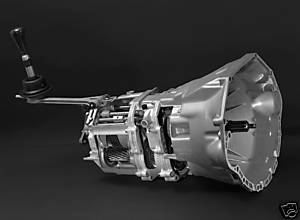Gearbox choices/dilemas :
The manual versions of the E34 530i/540i V8s were rare, and most were sold as autos. The E32 & E38 7-series also had a manual option but very few were sold.
BMW 5-series fanatics are often keen to get hold of the parts for E34 V8 manual conversions, so the kit of manual gearbox, clutch & flywheel can be expensive. Buying a whole parts car would probably be cheapest way to get hold of all the necessary parts. The 530i manuals were all 5-speed and the 540i manuals 6-speed, the later E39 540i 6-speed is more commonly available to buy seperately. But none are cheap.
I originally built the capri for a £999 challenge so to save costs i used a Ford Transit MT75 manual gearbox which has the same ratios to the Ford Sierra MT75 on 1-4 but 5th is taller and the casing is of more robust construction. The main problems with fitting a non-original gearbox are finding something with a bellhousing big enough to go over the large flywheel diameter, getting the input shaft the right length and matching the input shaft splines up with whatever clutch plate is used.
The 6-speed 540i manual gearbox is ideal if you can find one for a reasonable sum:

This is the Ford Transit MT75 gearbox i used :
The clutch arm works with the standard cable arrangement, and the pedal feel/heaviness is not too bad. The syncro on 2nd is poor (but this could just be my particular gearbox...)The gearstick position is quite a long way forward so i made up a cranked gearstick which works well but is aesthetically slightly odd. In the future i might get around to making up a remote shifter which would improve the feel of the box.
The standard clutch cable position (where it enters the bulkhead) is too close to the o/s cylinder head, so a new angled cable position had to be made to allow the cable to just clear the cylinder head but still keep in line with the pedal's action.
The adaptor to fit the transit box was cut from alloy plate. The transit bellhousing needed clearancing in various places to miss the nose of the starter motor, the rear coolant manifold and the bolts on the rear crank seal cover.
The lower gearbox mounting bolts go through a plate at the bottom of the new sump. In this pic the shinier plate is the alloy adaptor plate, and the black plate at the bottom forms the rear of the fabricated sump :
Engine and gearbox mated together (?) Bolted together.
Inside the car, the gearbox tunnel cover was cut out and re-made in welded sheet steel to clear the new gearbox. A new structural arch in 3mm steel carries the bolts for a new gearbox crossmember:
The C-section gearbox crossmember was made up from 3mm plate using a new Cortina/Capri gearbox mounting rubber attached to a plate that then aligns with the transit 'box's bolt holes.
In hindsight i would probably try and find a manual 530/540i or stick with the autobox as the hassle of adapting a different gearbox/clutch and the potential unreliability is perhaps not worth the money saved.
My car was originally a 1.6 so it had the 3.75 ratio axle which is really too high for a V8, as the engine doesn't really need to rev much to shift the car in everyday driving. Recently i fitted a 3.09 ratio set from a 3.0 V6 which has improved the driveability a lot.
The diff was stripped down and rebuilt with new carrier bearings and input shaft seals. I suspect that if these Atlas axles are in good condition they can take quite a lot of power but i guess it depends on how much traction is available. With no LSD and 205 tyres i like to think the chances of bending a halfshaft are slim as the friction generated against the tarmac isn't enough to load the components with massive forces (?) probably depends on how many drag-racing standing starts are performed. Thanks to the Escort rally brigade, lots of strengthened & uprated components are available for the Atlas axle if needed but they aren't as cheap as the bits for the american Ford 9" axles that all the drag racers use.